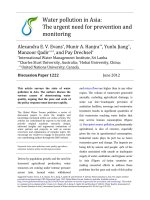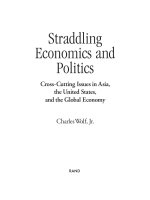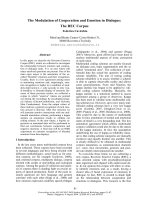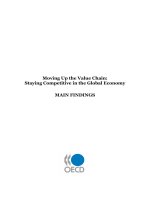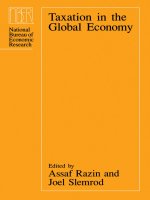Straddling Economics and Politics - Cross-Cutting Issues in Asia, the United States, and the Global Economy.pdf pot
Bạn đang xem bản rút gọn của tài liệu. Xem và tải ngay bản đầy đủ của tài liệu tại đây (450.79 KB, 228 trang )
Cross-Cutting Issues in Asia,
the United States,
and the Global Economy
Charl esWolf, Jr.
R
Straddling
Economics and
Politics
This publication was supported by RAND using its own funds.
RAND is a nonprofit institution that helps improve policy and
decisionmaking through research and analysis. RAND
®
is a
registered trademark. RAND’s publications do not necessarily reflect
the opinions or policies of its research sponsors.
© Copyright 2002 RAND
All rights reserved. No part of this book may be reproduced in any
form by any electronic or mechanical means (including
photocopying, recording, or information storage and retrieval)
without permission in writing from RAND.
Published 2002 by RAND
1700 Main Street, P.O. Box 2138, Santa Monica, CA 90407-2138
1200 South Hayes Street, Arlington, VA 22202-5050
201 North Craig Street, Suite 202, Pittsburgh, PA 15213-1516
RAND URL: />To order RAND documents or to obtain additional information,
contact Distribution Services: Telephone: (310) 451-7002;
Fax: (310) 451-6915; Email:
Library of Congress Cataloging-in-Publication Data
Wolf, Charles, 1924–
Straddling economics and politics : cross-cutting issues in Asia, the United
States, and the global economy / Charles Wolf, Jr.
p. cm.
“The 38 essays in this book were written between the end of 1996 and the
middle of 2001, and published in the Wall Street journal, [et al.]”—Forward.
“MR-1571.”
ISBN 0-8330-3181-3
1. Globalization—Economic aspects. 2. Globalization—Political aspects. 3. Free
enterprise. 4. International economic relations. 5. United States—Economic
policy—1993–2001. 6. United States—Economic conditions—20th century. 7.
United States—Politics and government—20th century. 8. Financial crises—Asia.
9. Asia—Economic policy—20th century. 10. Asia—Economic conditions—20th
century. 11. Asia—Politics and government—20th century I. Title.
HF1359 .W653 2002
330.9—dc21
2002069746
Cover design by Maritta Tapanainen
iii
FOREWORD
The 38 essays in this book were written between the end of 1996 and
the middle of 2001, and published in The Wall Street Journal, The
Asian Wall Street Journal, The Wall Street Journal Europe, The
Los Angeles Times, The New York Times, The International Herald
Tribune, The Weekly Standard, Critical Review, Society, The Milken
Review, and International Economy. All the essays appear in their
original, unedited form, and none has been altered in light of the
world-shaking and world-shaping terrorist attacks of September 11,
2001 on the World Trade Center in New York and the Pentagon in
Washington, D.C. Two of the essays (Chapter 29 and Chapter 35),
although written in 2001, weren’t published until early in 2002.
Most of the cross-cutting issues dealt with in these essays are as per-
tinent in the post– as in the pre–9/11 environment. Whether global-
ization is good or bad and for whom, how to measure it or how to
influence it, remain timely questions now as they were then. The ad-
mission of China and Taiwan to the World Trade Organization
(WTO), and the economic and other consequences of this change in
status, will continue to be of regional as well as global significance.
So, too, are issues addressed in other chapters, including the case for
and against a “new international economic architecture,” the out-
look for a strong or a weak euro, the ramifications of China’s contin-
ued if fitful progress toward capitalism, and the “fairness” and other
effects of changes in U.S. marginal tax rates or in government
spending as central elements in U.S. fiscal policy.
As indicated by this snapshot of the book’s contents, the subject
matter covers a wide range of disparate issues, reflecting matters I
iv Straddling Economics and Politics
have been interested in during this period. I have organized the
chapters into three parts to provide a semblance of cohesion:
I. The Global Economy, which includes chapters dealing with
globalization, financial crises, WTO, and the euro;
II. The U.S. Economy and Foreign Policy, which includes essays on
U.S. tax cuts, the trade and budget deficits, and whether and
when it makes sense for the U.S. military to intervene abroad;
and
III. Asian Economics and Politics, which comprises most of the
book’s chapters, spanning a wide range of topics from “Asian
values” and whether they differ from “western” ones, to eco-
nomic forecasts for the Asian region, to Asia’s recovery from the
1997–1998 financial crisis, and to numerous country-specific is-
sues involving China’s economic growth, cross-Strait relations
between the mainland and Taiwan, Japan’s economic stagna-
tion, and the eventual costs of Korean reunification.
Bridging this assortment of subjects and partly connecting them are
several prominent, cross-cutting themes.
First, the author is a strong, but not uncritical, adherent of free and
competitive markets, and of market mechanisms rather than gov-
ernment intervention to address economic problems. This theme
occurs and recurs in the three parts of the book in describing various
issues and in evaluating policy measures to deal with them. How-
ever, this stance does not proceed from a belief that markets, when
left to their own devices (e.g., “laissez-faire”), always manifest the full
range of attributes associated with perfect markets, to wit: full and
free competition; symmetric information available to buyers, sellers,
and potential competitors as well as current producers; generally
rising cost curves notwithstanding economies of scale and scope;
and so on. Indeed, it is typically the case that some of these attributes
are missing from real-world markets. Instead, my support for market
mechanisms derives from an empirically based belief that the
evident shortcomings of markets are frequently overbalanced by the
Foreword v
often neglected, overlooked, and unacknowledged drawbacks of
government efforts to redress the market’s shortcomings.
1
This theme recurs in Chapters 3, 4, 5, and 6 dealing with financial
crises, the International Monetary Fund, the problem of “moral haz-
ard,” and the continuing clash between reliance on markets or on
government intervention. The theme also appears in Chapters 24, 25,
27, 28, and 29. dealing with the Chinese economy, its prospects, and
its fitful march away from central planning and toward capitalism; in
Chapter 10 where a rebuttal is presented to George Soros’s alarmism
about “market fundamentalists” and his predicted collapse of the
global capitalist system; and in Chapters 32, 33, 34, and 35 dealing
with Japan’s economic malaise and possible remedies for it.
A second theme evident in several parts of the book is a pervasive
skepticism and criticism of U.S. efforts, however well intentioned, to
intervene in politically-charged, ethnically-complex, and murky
conflict environments, (such as Bosnia and Kosovo), along with pes-
simism about whether the expected good resulting from such efforts
exceeds a reasonable prognosis of the harm inflicted by them. (As
suggested earlier, this view would warrant reappraisal in the post–
September 11, 2001 environment—a reappraisal not attempted in
this book.) The theme is also manifested in Chapter 37 dealing with
the costs of Korean reunification if and when it occurs, and how to
effectuate it without such large foreign subventions to North Korea
as have been urged by others. Instead, I suggest that emphasis
should be placed on a more austere, closely monitored, quid pro quo
negotiatory and enforcement stance.
Third, and seemingly inconsistent with the preceding theme, is a
more activist inclination toward restarting cross-Strait discussions
between Mainland China and Taiwan. This theme appears, for ex-
ample, in Chapter 30, dealing with “One China and Three Systems,”
and Chapter 31 on restarting discussions between the two WTO par-
ties. The reason I characterize this as only “seemingly” inconsistent,
rather than blatantly inconsistent with the anti-activist position re-
ferred to earlier, is that the concrete policy suggestions offered in
______________
1
For an exposition and elaboration of the theory and evidence underlying this posi-
tion, see Charles Wolf, Jr., Markets or Governments: Choosing Between Imperfect
Alternatives, MIT Press, 1993.
vi Straddling Economics and Politics
these chapters do not specify how much of a role the United States
should play in this process. To be sure, this is a bit disingenuous
since the likelihood that the parties would actually do something
along the lines I suggest without an explicit and committed U.S.
initiative may be small. Attempting to reconcile my general aversion
to interventionism with this inclination to exert influence in tension-
easing directions in the case of China and Taiwan would at best be
labored. Suffice it to say that, at least in this instance, I agree with
Emerson’s dictum that “foolish consistency is the hobgoblin of little
minds”!
Fourth, several of the chapters try to envisage the economic and mili-
tary directions in which particular countries or regions are moving,
and what the movements portend for the future. Sometimes this
takes the form of formal economic forecasts, as in Chapters 17, 18,
and 19, in which forecasts are made for the principal Asian countries
of four key variables: gross domestic product (GDP), per capita GDP,
military spending, and the accumulation of military capital. Based on
these forecasts, comments are made about the Asian political and
security environment that may result from these trends. Underlying
the formal forecasts is a premise that two of the critical ingredients of
national power, and the relative stature and influence of countries,
are their economic size and growth, on the one hand, and their mili-
tary capabilities, on the other. While these are certainly not the only
ingredients of national power, they are among the most salient as
well as the most calculable ones. Elsewhere in the book, the forecasts
that appear are of a more qualitative and at least equally conjectural
sort, as in Chapter 33’s and 35’s assessment of Japan’s long term
prospects, and Chapter 26’s speculation about whether a freely and
fully convertible Chinese yuan would be more likely to trade at a de-
preciated or appreciated rate against the dollar.
Finally, I should acknowledge that some of my views that seemed on
track at the time they were expressed have turned out to be wide of
the mark when the future they were envisaging actually arrived. One
example: Chapter 13 expressed doubts that the consensus estimates
of a prospective ballooning of the U.S. trade and current account
deficits would materialize. Well, the consensus was correct; my
doubts proved to be wrong. Another example, Chapter 15, dealing
with taxes, trade, and growth in 1996, analyzed the savings-invest-
ment imbalance in the United States by principally emphasizing the
Foreword vii
insufficiency of domestic savings, rather than the excess of
investment. In hindsight, the investment boom and its excesses in
the late 1990s in fact led to domestic excess capacity and the
recession of 2001. So, while my crystal ball helped in some cases
(many relating to Asia), it obscured in others (several relating to the
United States!).
I have always believed that commentators—whether of a scholarly or
more journalistic bent—should be held to account for their pro-
nouncements. Whether such accountability through some type of
scoring system is provided by others or even by themselves, it has
seemed to me that it would serve a useful purpose by discouraging
hype and encouraging responsibility. With this aim in mind, I have
added a brief “Postaudit” at the end of each essay, indicating
whether, in my judgment, the essay seems currently to be valid and
relevant compared to when it was written. In my scoring system, 23
of the essays stand up to this test quite well (each receiving an “A” or
“A–”), ten warrant B’s (meaning they do passably well), and five re-
ceive C’s, which means they fail to make the cut! For those readers
who might be interested in the finer-grained evaluation, I did best on
Parts I and III—on the global economy and Asia, respectively—and
least well on Part II, dealing with the U.S. economy. The record is not
as good as I would have liked, yet better than that of such soothsay-
ers as George Soros, Robert Mundell, Paul Krugman, Fred Bergsten,
Jean-Claude Trichet, and several others mentioned in these essays.
Charles Wolf, Jr.
Santa Monica, CA
ix
CONTENTS
Foreword iii
Figures xiii
Tables xv
PART I: THE GLOBAL ECONOMY
CHAPTER 1
Globalization: Meaning and Measurement 3
CHAPTER 2
Globalization: Less Than Meets the Eye 15
CHAPTER 3
Financial Crises and the Challenge of “Moral Hazard” 19
CHAPTER 4
The Morning After 25
CHAPTER 5
Financial Flu Isn’t Contagious 31
CHAPTER 6
History Hasn’t Ended: The Struggle Between Markets and
Governments Resumes 35
CHAPTER 7
The WTO Controversy: Exaggerated Fears and Unrealistic
Hopes 41
CHAPTER 8
Economic Facts Point to a Weak Euro 47
x Straddling Economics and Politics
CHAPTER 9
E Pluribus Incertum Unum 51
CHAPTER 10
The Crisis of George Soros 55
PART II: THE U.S. ECONOMY AND FOREIGN POLICY
CHAPTER 11
Whether and When to Intervene 63
CHAPTER 12
Tax Cuts, Debt Reduction, and “Fairness”: Why Tax Reduction
Is No More “Unfair” Than Debt Reduction 67
CHAPTER 13
False Alarms About the U.S. Trade Deficit 71
CHAPTER 14
Two Deficits That Just Don’t Matter
(Co-Authored with Walter Wriston) 75
CHAPTER 15
Taxes, Trade, and Growth 79
PART III: ASIAN ECONOMICS AND POLITICS
CHAPTER 16
Are “Asian Values” Really That Unique? 85
CHAPTER 17
Through a Hazy Crystal Ball: Asia’s Economic Outlook,
1997–2020 89
CHAPTER 18
Asia in 2015 101
CHAPTER 19
The Accumulation of Military Capital in Asia and the
United States, 1997–2015 107
CHAPTER 20
Too Much Government Control 113
CHAPTER 21
The End of Asia’s Economic Crisis 119
Contents xi
CHAPTER 22
When Good News Isn’t Newsworthy 125
CHAPTER 23
Asia’s Dramatic Recovery 129
CHAPTER 24
China After Deng 133
CHAPTER 25
Why China’s 8 Percent Growth Target Is Not Good News 137
CHAPTER 26
China’s Devaluation: Whether, When, How Much? 141
CHAPTER 27
China’s Hierarchs Face a Critical Dilemma 145
CHAPTER 28
Communists and Capitalists in China: Who Will
Co-Opt Whom? 149
CHAPTER 29
China Continues Its Fitful March Toward Capitalism 153
CHAPTER 30
One China, Three Systems? 157
CHAPTER 31
Restarting Cross-Strait Relations:
Beyond the Dialogue of the Deaf
(Co-authored with Jonathan Pollack) 161
CHAPTER 32
Curing Japan’s Economic Malaise 165
CHAPTER 33
Long-Term Prospects for Japan 171
CHAPTER 34
New Therapies for Japan’s Economic Sclerosis
(Co-Authored with Mark Buchman) 183
CHAPTER 35
Japan’s Comfortable Stagnation 189
CHAPTER 36
How to Defend Japan While “Engaging” China 193
xii Straddling Economics and Politics
CHAPTER 37
When a Balance of Power Can Be Destabilizing 197
CHAPTER 38
Managing the Costs of Korean Reunification—If It Occurs 201
Index 205
About the Author 211
xiii
FIGURES
1.1. Integration of Global Capital Markets:
One Indicator 8
17.1. GDP Estimates for Asian Countries, Germany,
and the United States, 1997–2015 93
17.2. Per Capita GDP Estimates for Asian Countries,
Germany, and the United States 95
19.1. Military Capital Estimates, 1997–2015 108
xv
TABLES
1.1. Exports as a Percentage of GDP, 1870–1999 7
1.2. Aggregate Response Means from Business
Questionnaire 9
1.3. Aggregate Openness Index Based on Authors’
Evaluations of Administrative and Legal
Regulations 10
1.4. Normalized Differences Between Purchasing Power
Parities (PPP) and Exchange Rates (XRs),
1991–1995 Averages 10
17.1. Forecasted Annual GDP Growth Rates, 1997-2015:
Principal Asian Economies, United States,
and Germany 91
18.1. Gross Domestic Products, 2015 102
18.2. Military Capital, 2015 104
Part I
The Global Economy
3
Chapter 1
GLOBALIZATION: MEANING AND MEASUREMENT
1
1. Rhetoric and Spin
Millions of words have been written, hundreds of conferences con-
vened, and dozens of books published about globalization. Yet the
subject remains clouded, if not obscured, by the rhetoric surround-
ing it.
The situation recalls a comment by an 18th century philosopher,
sometimes referred to as the “first American.” Said Benjamin
Franklin (I paraphrase slightly): Where there is “a flood of words,”
there is usually only “a drop of reason.”
Or, to cite an anonymous 17th century poet: “Where words most
abound, much sense beneath is rarely found.”
As a result of the rhetoric, media hype, and spin associated with
globalization, as well as the occasionally violent demonstrations
against it, globalization has become a convenient scapegoat for
many things—indeed, for almost anything, and sometimes seem-
ingly for everything. Globalization has been blamed for the Asian fi-
nancial crisis of 1997–1998, the Russian economic plunge in 1999,
global warming, hormone-treated beef, the spread of foot-and-
mouth disease in Europe, and even piracy in the South China Sea!
______________
A slightly edited version was published in Critical Review on April 30, 2001 under the
same title.
1
Based on a presentation originally made at the 3rd annual conference between RAND
and the China Reform Forum, held in Beijing in November 2000, on The Challenges of
Globalization.
4 Straddling Economics and Politics
The phenomenon recalls the role of the Vietnam war as an all-pur-
pose scapegoat for anything that went wrong in the 1960s and 1970s:
stagflation in the United States, the drug culture in the United States
and Europe, even the sharp increase in teenage pregnancy in the
United States.
Use of the term “scapegoat” doesn’t mean that globalization has had
no contributory responsibility for any of the untoward developments
mentioned above. But in each case the predominant causes and re-
sponsibilities lie elsewhere. For example, the Asian financial crisis
was mainly caused by misguided policies, especially by maturity
mismatches between the terms on which funds were borrowed and
those on which they were invested, rather than by anything properly
attributable to globalization.
2. What Does It Mean?
The word has been used in so many different contexts, and with so
many different connotations, that it recalls Humpty Dumpty’s pro-
nouncement: “When I use a word it means just what I choose it to
mean—neither more nor less.” Still, it would seem desirable to arrive
at a reasonably clear definition of globalization before considering
how to measure it.
At a simple, dictionary level, globalization is defined as “The act, pro-
cess, or policy of making something worldwide in scope or applica-
tion.” Before dismissing this definition as too simplistic, it is worth
recalling an observation by Ernest Rutherford that unless you can
state a technical point in simple, non-technical language, you prob-
ably don’t really understand it!
Other definitions include the following, more or less in order of in-
creasing complexity:
“[Globalization is] the intensification of worldwide social rela-
tions…in such a way that local happenings are shaped by events
occurring many miles away.” (Anthony Giddens, 1990)
“Globalization reflects a more comprehensive level of interaction
than in the past, something different from the word ‘international.’
It implies a diminishing importance of national borders and the
Globalization: Meaning and Measurement 5
strengthening of identities…beyond those rooted in a particular re-
gion or country.” (Ford Foundation Report, 1997)
“Globalization is the growing economic interdependence of coun-
tries worldwide through the increasing volume of cross-border
transactions in goods and services and of international capital
flows, and also through the more rapid and widespread diffusion of
technology.” (International Monetary Fund, 2000)
“Globalization is not a policy option, but a fact…The emerging re-
ality is that all nations’ militaries are sharing essentially the same
global commercial-defense industrial base.” (Donald Hicks, De-
fense Science Board, 2000)
The first three of these quotations are representative of many generic
definitions, while the fourth has a more distinctive, and perhaps
slightly paradoxical, quality. The paradox is that, while proclaiming
globalization as a “fact” and not a “policy option,” its focus on the
“emerging reality” of a “shared global commercial-defense industrial
base,” actually opens up a wide range of differing policy options: for
example, easing or restricting controls on the export of military or
dual-use technologies, procuring military equipment abroad or con-
fining procurement to defense industry at home, and so on.
I suggest the following, somewhat syncretic definition, which will
underlie much of what follows in this paper:
“Globalization is the increased speed, frequency, and magnitude of
access to national markets by non-national competitors.”
In defining globalization this way, I intend it to encompass all mar-
kets: social, cultural, and recreational markets, including markets for
intellectual property, literature, film, media, music, and sports, as
well as those for merchandise and commercial services.
3. Measurement Issues and Applications
The preceding definition implies several tendencies in global and na-
tional markets, and the conditions we should expect to find or to im-
pend as globalization proceeds. These conditions should, in turn,
6 Straddling Economics and Politics
affect the identification and design of appropriate indicators or met-
rics for globalization.
First, and most obviously, this definition implies that global markets
have become and are becoming more integrated.
Second, increased access to national markets by non-national com-
petitors suggests that disparities across countries in prices, wages,
and real interest rates (after allowing for the costs of hedging against
exchange-rate risks), should decrease.
Third, with the decline in price gaps among countries, price correla-
tions between markets should increase, and divergences of output
patterns across markets should rise due to enhanced opportunities
for specialization and the effect of comparative advantage.
Fourth, differences between savings rates and investment rates
within countries should increase (because investment rates will be
less dependent on savings rates than has been true in the past).
Typically, measurement of globalization has focused on the magni-
tudes of trade transactions and capital flows, based on the premise
that the larger these magnitudes, the greater the prevalence or ex-
pansion of globalization. Yet, the volume of trade and capital flows
are at best imperfect indicators, because of various problems con-
nected with them. For example, trade and capital transactions are
subject to wide fluctuations, and the reliability and comparability of
the underlying data are often questionable. Trade can be distorted
through national policies—such as subsidies to raise exports and
tariffs or non-tariff barriers to restrict imports. Consequently, such
policies may obscure underlying globalization trends, or may some-
times even make such trends appear stronger than they in fact are.
Notwithstanding these problems, one frequently used indicator of
globalization is exports as a proportion of gross domestic (or global)
product. Table 1.1 summarizes the long-term trend in global exports
as a percent of global product, from 1870 to 1999.
As the figures in Table 1.1 indicate, this ratio as an indicator of global-
ization isn’t monotonic: it moves up and down over time. Indeed, in
the 1990s—the period of what has typically been viewed as a relent-
Globalization: Meaning and Measurement 7
Table 1.1
Exports as a Percentage of GDP, 1870–1999
Year
1870 1913 1950 1973 1987 1995 1999
5.9 8.2 5.2 10.3 12.8 17.3 15.0
SOURCES: Kevin H. O'Rourke and Jeffrey G. Williamson, Globalization and
History, MIT Press, 1999.; Department of Commerce, Bureau of Economic
Analysis, 1995, 1999. Data for 1870–1987 cover only merchandise exports for
OECD countries; data for 1995–1999 are global and cover all exports.
less move toward globalization—the ratio fell between 1995 and
1999.
The volume of international capital flows is another useful and rele-
vant, although also imperfect, indicator of globalization. As with
trade data, the data on capital flows are also subject to distortions of
various sorts; for example, by tax policies, government-subsidized
investment guarantees, and other measures designed to promote or
impede such flows.
Interestingly, and contrary to some conventional wisdom, O’Rourke
and Williamson (1999) have found that foreign capital flows relative
to domestic savings were considerably larger at the start of the 20th
century than at its end! However, whereas capital flows at the turn of
the century were overwhelmingly in the form of loans, now they
consist mainly of foreign direct investment and, to a lesser extent, of
portfolio equity investment. One particular form of current capital
flows that was virtually non-existent in bygone periods is foreign di-
rect investment (FDI) associated with transborder mergers and ac-
quisitions (M&A). For example, in 1999, FDI for M&A amounted to
$800 billion, representing an increase of almost 50 percent from the
prior year.
As noted earlier, we might expect on theoretical grounds that global-
ization should be associated with widening differences between do-
mestic savings and investment rates as a result of greater integration
of global capital markets. Figure 1.1 hows the varying correlations
between domestic savings and investment rates from 1872 to 1987.
While a lower coefficient (the vertical axis of Figure 1) implies a
higher degree of integration of global capital markets, Figure 1
shows—once again contrary to much conventional wisdom—that
8 Straddling Economics and Politics
Regression coefficients of domestic
investment/domestic savings shares
Feldstein–Horioka coefficient
0.2
0.4
0.6
0.8
1.0
1.2
1872 1882 1892 1902 1912 1922 1932 1942 1952 1962 1972 1982
SOURCE: Kevin H. O’Rourke and Jeffrey G. Williamson.
Globalization and
History
, MIT Press, 1999; A. M. Taylor,
International Capital Mobility in History:
The Saving-Investment Relationship
, National Bureau of Economic Research,
Cambridge, Mass., 1996.
NOTE: Lower correlation implies greater integration of capital markets. Data
are for Atlantic economies.
RAND
MR1571-1.1
Figure 1.1—Integration of Global Capital Markets: One Indicator
capital markets appear to have been more closely integrated before
World War I than they currently are!
In an effort to develop new and improved measures of economic
“openness”—an important aspect, if not synonym, of globalization—
a recent RAND study devised three additional measures of the rela-
tive degree of market access (i.e., economic openness) in five coun-
tries: the United States, Germany (as a proxy for the European
Union), China, Japan, and South Korea.
2
The three measures are:
______________
2
See Charles Wolf, Jr., Hugh Levaux, and Daochi Tong. Economic Openness: Many
Facets, Many Metrics. RAND, MR-1072-SRF, Santa Monica, California, 1999.
Globalization: Meaning and Measurement 9
• a survey questionnaire relating to the relative ease or difficulty of
engaging in trade or investment business in the five countries,
distributed to the top executives responsible for international
operations in 500 multinational corporations;
• a detailed review of legal and administrative documents in each
of the countries to assess the extent to which foreign business
operations were restricted or prohibited;
• comparisons between the purchasing power parity (so-called
“real”) value of each country’s currency, and its foreign exchange
(“nominal”) value. (The rationale underlying this measure is that,
other things equal, the more “open” an economy, the closer
should be the PPP and foreign exchange values of its currency,
and conversely.)
The survey was conducted over a five-month period in late 1997 and
early 1998 with a response rate of 60 percent. Respondents were
asked to respond to a 10-page questionnaire, rating each of the five
countries according to a six-point scale (from zero to five) as to the
degree of restrictiveness prevailing in each of the countries. Table 1.2
shows the aggregate response means from the survey.
Table 1.3 shows the openness index resulting from the review of legal
and administrative documents and regulations referred to above.
Table 1.2
Aggregate Response Means from Business Questionnaire
Country
Openness
in
Trade
Openness
in Invest-
ment
Aggregate
Openness
a
United States 1.71 0.97 1.35
European
Union 2.43 1.67 2.07
Japan 3.34 2.86 3.13
South Korea 3.21 3.42 3.30
China 3.41 3.94 3.64
a
Aggregate index is based on the aggregate answers to 20
questions in the openness questionnaire: low index values
signify less restriction, hence greater economic openness.
The aggregate index is an unweighted average of the trade
and investment indexes, subject to rounding.

